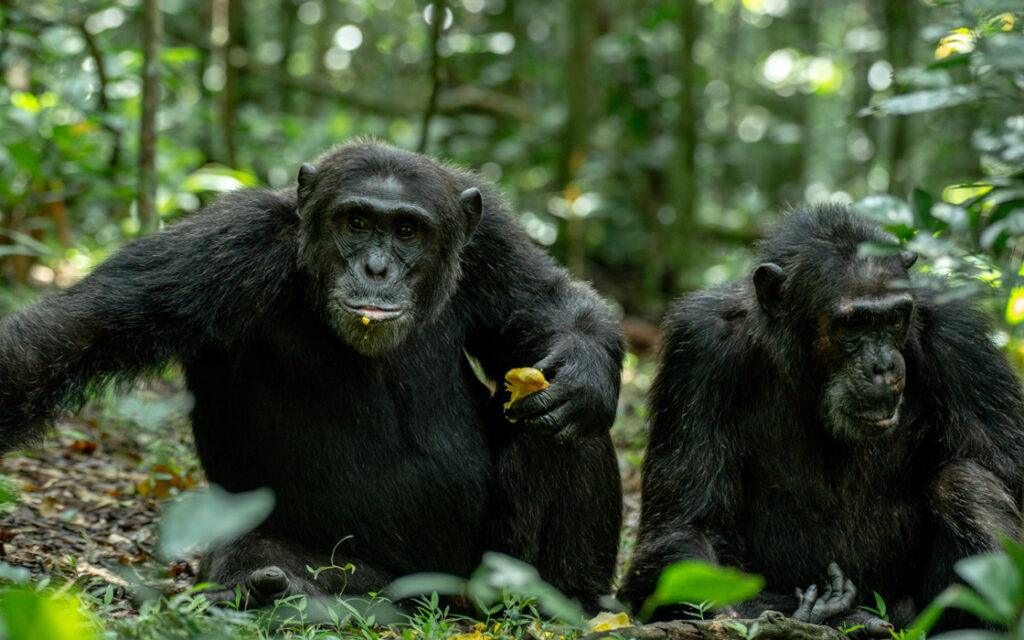Why do chimpanzees fight for power at Kibale National Park?

Kibale National Park, located in western Uganda, is a biodiverse haven encompassing an array of ecosystems, from moist evergreen rainforests to expansive grasslands. One of its most captivating features is its thriving chimpanzee population, making it a sanctuary for these intelligent and social creatures.
The park covers approximately 795 square kilometers and harbors an estimated 1,500 chimpanzees, making it a prime location for the study of their behavior and social dynamics.
The Chimpanzee Society in Kibale National Park
Kibale National Park provides a unique backdrop for the study of chimpanzee social structures. The chimps in this park live in multi-female, multi-male communities where complex social interactions play a crucial role in their everyday lives.
Social Organization
Chimpanzee groups in Kibale are matriarchal, led by an alpha male and several females. The alpha male, often the most dominant and powerful individual, maintains control over the group, regulating social behaviors and mediating conflicts. The females, tightly bonded within their community, establish intricate relationships through grooming, social play, and cooperation in childcare.
Communication and Hierarchy
Communication is a fundamental aspect of their social structure. Chimpanzees communicate through a diverse range of vocalizations, gestures, and body language, displaying emotions, intentions, and warnings. The hierarchy within the group is maintained through displays of power and subtle cues, often observed through grooming rituals and submissive behaviors.
Territorial Nature
The concept of territory is crucial for chimpanzees in Kibale National Park. Each community defends a defined territory, marked by patrolling the boundaries and engaging in confrontations with neighboring groups. These territories are essential for securing food resources and ensuring the safety and survival of the members.
Dynamics of Dominance and Territory
At the core of a chimpanzee community lies a dominance hierarchy, where the alpha male typically maintains the highest rank. However, the alpha’s dominance isn’t solely achieved through physical prowess; rather, it is a complex amalgamation of social intelligence, strategic alliances, and the ability to negotiate conflicts within the group. The alpha male exerts authority, often maintaining a level of control over resources, mating opportunities, and decision-making within the troop.
Challenges and Power Struggles
Within the troop, there might be power struggles and challenges to the alpha’s authority. Younger males, as they mature, might attempt to challenge the alpha’s position by forming coalitions or exhibiting strong, assertive behaviors. These challenges could result in aggressive confrontations or subtle negotiations, determining the hierarchical shifts within the group.
Territorial Behavior
Chimpanzees exhibit territorial behavior, demarcating areas that they consider their own. These territories are not rigidly defined but are established along the edges of their range, which often overlap with neighboring groups. The conflicts arise when these borders are contested, leading to vocal displays, such as hooting and drumming, as well as physical confrontations.
Communication and Conflict Resolution
Chimpanzees employ a range of communication methods to assert dominance and resolve conflicts. Besides vocalizations, they use body language, grooming rituals, and displays of strength to communicate within the group and with rival groups.
Conflict resolution can involve displays of power to deter aggression, reconciliation through grooming, or, in certain instances, the intervention of higher-ranking individuals to restore peace.
When it comes to violence…
Territorial disputes form the foundation of inter-group violence among chimpanzees. The boundaries of their territories are not fixed and can overlap, leading to conflicts over access to critical resources. These resources include fruit trees, hunting grounds, and areas suitable for nesting. When food sources become scarce or are contested, tensions rise, often resulting in aggressive encounters.
Chimpanzee groups strive to maintain their territories to secure access to these vital resources. Encroachment by rival groups into their established areas often triggers confrontations as defending their territory becomes crucial for ensuring the well-being and survival of their group members.
Aggression and Display of Power
Inter-group conflicts are not solely about physical altercations. Aggression often manifests through various displays of power and intimidation. These displays include loud vocalizations, such as hooting, screaming, and drumming on tree roots. These vocalizations serve as warnings and can escalate to aggressive charges, branch shaking, and throwing of objects.
The most extreme form of aggression involves physical confrontations, including hitting, biting, and chasing rival group members. These encounters can result in severe injuries and, in rare cases, even death among the chimpanzees. The alpha males often take the lead in these conflicts, asserting dominance and attempting to defend their group’s territory and members.
Aggressive Encounters
Instances of inter-group violence in Kibale National Park often involve confrontations that showcase the intensity and variety of chimpanzee aggression. For example, confrontations might begin with vocal displays from both groups, signaling their presence and boundaries. These vocal exchanges can escalate if one group attempts to invade the other’s territory, leading to aggressive charges and physical altercations.
In one observed incident, two rival groups clashed when one encroached on the feeding area of the other. The confrontation intensified with loud vocalizations and physical aggression as both groups sought to defend their access to a particularly abundant fruit tree.
Another example highlighted the strategic alliances within chimpanzee groups. Two smaller groups formed a temporary coalition against a larger, more dominant group. This coalition resulted in a display of collective aggression to challenge the authority of the larger group over a shared boundary.
Behavioral Observations and Research Efforts
Observational Studies
Researchers at Kibale National Park have conducted extensive observational studies to understand the behavior and social dynamics of the chimpanzee communities. These studies involve direct observation of their daily activities, interactions, and communication within the groups. Ethologists spend hours in the field, meticulously documenting behaviors such as grooming, foraging, mating rituals, and territorial displays.
Through these studies, scientists have unraveled the complexities of their communication, identifying various vocalizations, gestures, and postures that convey messages within the group. These observations have provided insights into the hierarchical structure, identifying the alpha male and the roles of females and juveniles within the community.
Long-term Field Research
Long-term field research involves continuous and consistent observation of specific chimpanzee communities over extended periods. Scientists, often working in remote and challenging conditions, habituate specific groups of chimpanzees to human presence. This habituation process allows researchers to get closer to the chimpanzees without causing significant disruption to their natural behaviors.
The long-term data collected from these habituated groups enable researchers to understand individual personalities, social relationships, and changes within the community over time. Such research also tracks life events like births, deaths, migrations, and the ascension and decline of alpha males, providing critical information on the dynamics of their society.
Technology and Innovations
Technology has significantly enhanced the scope of chimpanzee research in Kibale. GPS tracking collars, for instance, have provided precise information about the chimpanzees’ ranging patterns and territorial movements. These collars allow researchers to track their daily journeys, understand their home ranges, and analyze how these ranges intersect with neighboring groups.
Camera traps and remote monitoring devices have also been instrumental. These devices capture footage and images, offering a non-invasive way to observe chimpanzee behavior. This technology has been vital in studying their nocturnal activities and behaviors when human observers cannot be present.
Human Impact and Conservation Efforts
The expansion of agricultural land and human settlements has reduced the available forested areas for the chimpanzees. This habitat loss not only limits their foraging grounds but also fragments their territories, disrupting their social structures. The decreasing availability of food sources due to habitat fragmentation and destruction often leads chimpanzees to venture into human settlements in search of sustenance, creating conflict situations.
This human-wildlife conflict poses risks to both humans and chimpanzees. Crop raiding by the chimpanzees can lead to retaliation from local communities, resulting in injury or death to the animals. Conversely, the chimpanzees may suffer from traps or snares set out by locals to protect their crops. Such conflicts can fuel negative attitudes towards the conservation of these primates.
To counteract these threats and preserve the habitat and well-being of the chimpanzees, several conservation initiatives have been established within Kibale National Park and its surrounding areas.
Protected Areas and Corridor Creation
One significant strategy involves establishing protected areas and wildlife corridors. These spaces are designated to maintain the integrity of the chimpanzees’ habitat and ensure connectivity between fragmented forest patches. Creating corridors between these patches allows the chimps to move between areas, maintain gene flow, and access various resources essential for their survival.
Community-Based Conservation and Education
Community involvement is key to successful conservation efforts. Collaborating with local communities bordering the park helps mitigate human-wildlife conflicts. Educational programs raise awareness about the importance of conservation, teach sustainable agricultural practices, and offer alternative livelihood options to reduce dependence on the forest.
Sustainable Land Use Practices
Encouraging sustainable land use practices among local communities is vital. Implementing agroforestry techniques, which integrate trees with agricultural crops, not only preserves forest cover but also provides additional income sources and helps mitigate crop raiding by wildlife.
Research and Monitoring
Continuous research and monitoring efforts are crucial to understand the changing dynamics within chimpanzee populations and their habitat. Tracking population sizes, behavior patterns, and their responses to changing environments provide valuable insights for effective conservation strategies.










